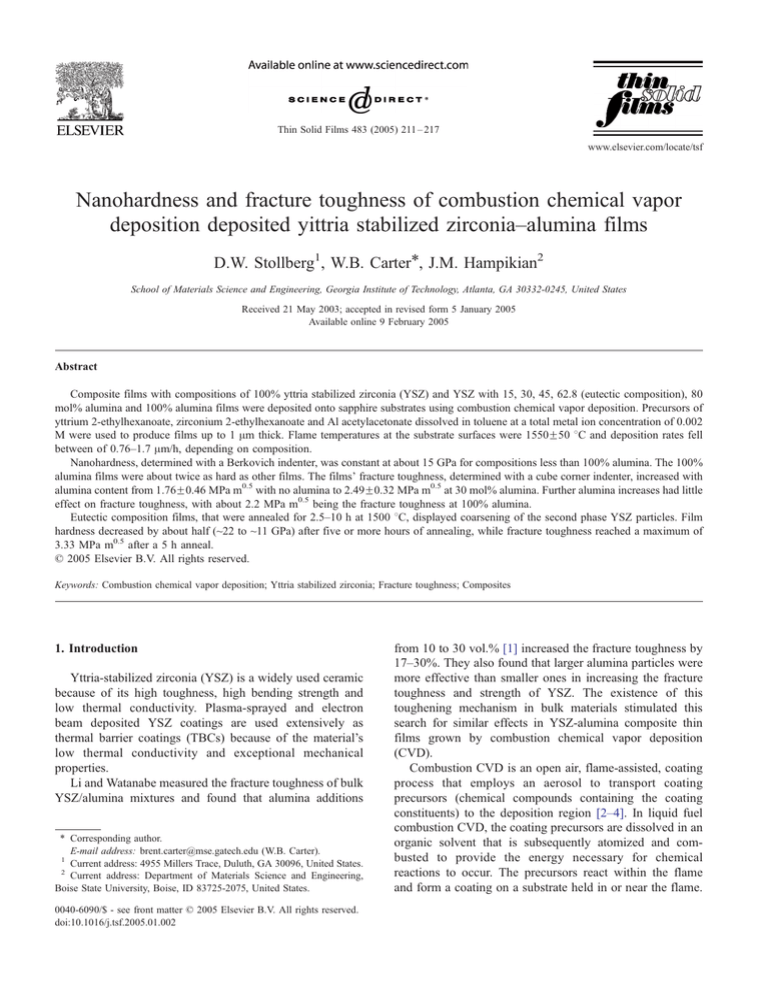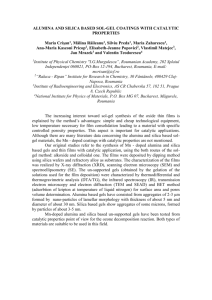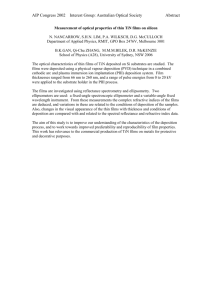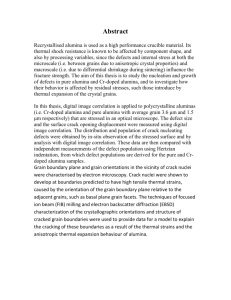
Thin Solid Films 483 (2005) 211 – 217
www.elsevier.com/locate/tsf
Nanohardness and fracture toughness of combustion chemical vapor
deposition deposited yittria stabilized zirconia–alumina films
D.W. Stollberg1, W.B. CarterT, J.M. Hampikian2
School of Materials Science and Engineering, Georgia Institute of Technology, Atlanta, GA 30332-0245, United States
Received 21 May 2003; accepted in revised form 5 January 2005
Available online 9 February 2005
Abstract
Composite films with compositions of 100% yttria stabilized zirconia (YSZ) and YSZ with 15, 30, 45, 62.8 (eutectic composition), 80
mol% alumina and 100% alumina films were deposited onto sapphire substrates using combustion chemical vapor deposition. Precursors of
yttrium 2-ethylhexanoate, zirconium 2-ethylhexanoate and Al acetylacetonate dissolved in toluene at a total metal ion concentration of 0.002
M were used to produce films up to 1 Am thick. Flame temperatures at the substrate surfaces were 1550F50 8C and deposition rates fell
between of 0.76–1.7 Am/h, depending on composition.
Nanohardness, determined with a Berkovich indenter, was constant at about 15 GPa for compositions less than 100% alumina. The 100%
alumina films were about twice as hard as other films. The films’ fracture toughness, determined with a cube corner indenter, increased with
alumina content from 1.76F0.46 MPa m0.5 with no alumina to 2.49F0.32 MPa m0.5 at 30 mol% alumina. Further alumina increases had little
effect on fracture toughness, with about 2.2 MPa m0.5 being the fracture toughness at 100% alumina.
Eutectic composition films, that were annealed for 2.5–10 h at 1500 8C, displayed coarsening of the second phase YSZ particles. Film
hardness decreased by about half (~22 to ~11 GPa) after five or more hours of annealing, while fracture toughness reached a maximum of
3.33 MPa m0.5 after a 5 h anneal.
D 2005 Elsevier B.V. All rights reserved.
Keywords: Combustion chemical vapor deposition; Yttria stabilized zirconia; Fracture toughness; Composites
1. Introduction
Yttria-stabilized zirconia (YSZ) is a widely used ceramic
because of its high toughness, high bending strength and
low thermal conductivity. Plasma-sprayed and electron
beam deposited YSZ coatings are used extensively as
thermal barrier coatings (TBCs) because of the material’s
low thermal conductivity and exceptional mechanical
properties.
Li and Watanabe measured the fracture toughness of bulk
YSZ/alumina mixtures and found that alumina additions
T Corresponding author.
E-mail address: brent.carter@mse.gatech.edu (W.B. Carter).
1
Current address: 4955 Millers Trace, Duluth, GA 30096, United States.
2
Current address: Department of Materials Science and Engineering,
Boise State University, Boise, ID 83725-2075, United States.
0040-6090/$ - see front matter D 2005 Elsevier B.V. All rights reserved.
doi:10.1016/j.tsf.2005.01.002
from 10 to 30 vol.% [1] increased the fracture toughness by
17–30%. They also found that larger alumina particles were
more effective than smaller ones in increasing the fracture
toughness and strength of YSZ. The existence of this
toughening mechanism in bulk materials stimulated this
search for similar effects in YSZ-alumina composite thin
films grown by combustion chemical vapor deposition
(CVD).
Combustion CVD is an open air, flame-assisted, coating
process that employs an aerosol to transport coating
precursors (chemical compounds containing the coating
constituents) to the deposition region [2–4]. In liquid fuel
combustion CVD, the coating precursors are dissolved in an
organic solvent that is subsequently atomized and combusted to provide the energy necessary for chemical
reactions to occur. The precursors react within the flame
and form a coating on a substrate held in or near the flame.
212
D.W. Stollberg et al. / Thin Solid Films 483 (2005) 211–217
The deposition process is controlled by managing several
variables that include substrate temperature, precursor
concentration and composition, aerosol size distribution,
solvent composition and nozzle configuration.
Combustion CVD has been successfully used over the
past several years to deposit high quality thin oxide films
including: yttrium barium cuprate (YBa2Cu3Ox), yttriastabilized zirconia (Y2O3-stabilized ZrO2), ceria (CeO2),
barium titanate (BaTiO3), alumina (Al2O3), silica (SiO2),
lanthanum phosphate (LaPO 4 ), magnesium spinel
(MgAl2O4) and nickel spinel (NiAl2O4) [2,5–10].
The present work examines the hardness and fracture
toughness of YSZ-alumina composite thin films (~1 Am
thick) deposited via combustion CVD. Film compositions of
100% YSZ and YSZ with 15, 30, 45, 62.8 (eutectic
composition), 80 mol% alumina and 100% alumina
deposited onto sapphire substrates were studied.
2. Experimental procedures
2.1. Deposition
Films were deposited onto single crystal, a-plane
sapphire substrates (approximately 1 cm1 cm1 mm)
suspended in deposition flames using supports fashioned
from AlCrFe alloy wire [Kanthal A-1 wire, Kanthal Corp.,
Bethel, CT] such that the flame made an angle of
approximately 458 with respect to the substrate normal.
The flames resulted from the combustion of aerosolized
solutions of reagent grade toluene in which were dissolved
organic or inorganic salts containing the desired metals ions
(Y, Zr and Al). Additional dry oxygen necessary for
complete combustion was supplied to the flames through
the nozzle. A hydrogen fueled pilot flame ensured continuous combustion.
Deposition temperature was controlled by varying the
location of the substrate relative to the tip of the flame. A
type K thermocouple attached to the back of the substrate
monitored the substrate temperature, while a type B
thermocouple was used to monitor the flame temperature
adjacent to the substrate. Substrate temperatures were in the
range of 800–1150 8C. Flame temperatures were in the
range of 1000–1650 8C. The deposition parameters are
summarized in Table 1.
The yttria content of the zirconia was 8 wt.% (4.5 mol%),
which is a composition commonly used in TBCs. Films
were made containing 0, 15, 30, 45, 62.8, 80 and 100 mol%
alumina. The zirconia–alumina eutectic occurs at 62.8 mol%
(57.4 wt.%) Al2O3.
2.2. Characterization
Phase identification was accomplished via X-ray diffraction in an automated powder diffractometer and electron
diffraction in a transmission electron microscope (TEM).
Table 1
Deposition parameters
Solvent
Precursors:
Solution flow rate
Total metal concentration of precursor solution
Nebulizer
Oxidizer
Oxidizer flow rate
Deposition rate
Flame temperature
Substrate temperature
Substrate
Pilot flame fuel
Deposition duration
a
b
Toluene
Yttrium 2-EHa
Zirconium 2-EH
Aluminum acacb
4 ml/min
0.002 M
Proprietary
Oxygen
20 lpm
1.8–2.5 Am/hr
1350–1650 8C
800–1150 8C
a-plane alumina
Hydrogen
30 min
2-ethylhexanoate.
acethylacetonate.
The TEM was equipped with an oxygen-sensitive energy
dispersive spectroscopy (EDS) system, which was used for
determining the composition of individual grains. Grain
sizes were determined from dark field images obtained in
the TEM. Several TEM specimens were prepared by
scraping the film with a clean sharp stainless steel blade
onto a copper TEM specimen grid. Other plan-view and
cross-section TEM specimens were prepared using standard
thin foil preparation techniques, including ion milling.
Because of the low milling angle (68 with respect to the
foil surface) and the thickness of the films (~0.75 Am), the
analysis areas of the plan-view foils were determined to
contain film only (no substrate).
Plan-view and fracture cross-sectioned specimens were
examined in a scanning electron microscope (SEM) to
characterize film morphology and film thickness. Compositional analysis was also performed in the SEM using
backscatter electron imagery and EDS. Quantitative image
analysis was performed on SEM backscatter electron and
high resolution TEM images of all two-phase films to
determine average particle sizes of minority phase, area
percentages (approximately equivalent to volume percent
assuming uniform distribution of the two components (YSZ
and alumina) in the third dimension), and nearest neighbor
distances.
Nanohardness were determined using the Nanoindenter
IIR at the Oak Ridge National Laboratory’s High Temperature Materials Laboratory employing the continuous stiffness method of Oliver and Pharr [11]. An array of 15
indentations, 15 Am apart, were made in each sample using
a Berkovich diamond indenter tip. A loading/unloading
procedure of 1) load, 2) hold at 50 nm indentation depth, 3)
load, 4) hold at 100 nm, 5) load, 6) hold at 200 nm, and 7)
unload. Hardness values were determined at the hold
segments in order to correct for thermal and equipment drift.
Fracture toughness, K c , was determined for each film
using the indentation method developed by Lawn et al. [12]
(see equation below), where P is the applied load, c the
D.W. Stollberg et al. / Thin Solid Films 483 (2005) 211–217
Fig. 1. Cross sectional SEM micrographs of YSZ-alumina films. (a) 100%
YSZ, (b) 80 mol% Al2O3. The substrate is on the left in both images.
crack length, and a a constant which equals 0.032 for a
cube-corner indenter tip, such as used here.
1=2
E
P
KC ¼ a
H
c3=2
Nanohardness values, H, were obtained as described
above. Elastic moduli, E, were also obtained from the
NanoindenterR data using the methods described by Oliver
and Pharr, and others [12–14]. Scanning electron microscopy (SEM) was used to measure the crack lengths. Five
indents were made 25 Am apart at five different loadings:
25, 50, 100, 250 and 400 mN, resulting in a total of 25
indentations. The highest load indents were used only for
locating the matrix of indents in the SEM due to the large
depth of penetration through the film into the substrate and
delamination of the film, while the lower loads were used
for crack measurements.
The fracture toughness results for each composition were
an average of values from two separate films, each with at
least 20 indents and each indent with one to three cracks.
The error associated with the fracture toughness values
represents the variation in crack lengths.
213
secondary and backscatter electron images of 15, 30, and
45 mol% alumina films. The two distinct components
(YSZ and alumina) are visible in the secondary electron
images (left), however, they are more distinct in the
backscatter electron images (right) in which the Al2O3
appears dark and the YSZ light. Although the alumina is
distributed in a bswirl-typeQ morphology that appears as if
it may have been molten, a simple heat balance computation indicates that it is not possible for the heat of
reaction to melt either the alumina (T MN2000 8C) or the
zirconia (T MN2600 8C) in the flame because of the low
deposition rates and the large radiation losses as the
temperature increases towards the melting temperature
(radiation losses are proportional to T 4).
Effective particle sizes were computed for these films
using the equivalent circle diameter method [15] applied to
the SEM plan view images (see Table 2). In the higher
alumina content films (not shown), the minority component
(YSZ) is present as fairly uniform sized spherical particles.
The average minority phase particle size decreases steadily
as the amount of alumina in the films increases. Thus, for
YSZ minority compositions, the YSZ particle size increases
with YSZ content, the opposite of what occurs for alumina
minority compositions.
The volume percentages of the two phases were
estimated by their area percentages in the SEM images
(see Table 3). These compositions agree with those of the
3. Results and discussion
Two of the most important process parameters were the
aerosol size and the deposition temperature. A proprietary
nozzle allowed precise control of the aerosol size. The
substrate temperature was used as the guide for depositions
and varied only on the order of F10 8C, while the flame
temperature varied F50 8C.
Film thickness varied from 0.7–1.0 Am over the compositional range studied. Deposition rates varied with composition from 1.3F0.1 Am/h for pure YSZ to a maximum of
1.7F0.1 Am/h for the eutectic composition. The deposition
rate was lowest for pure alumina at 0.76F0.18 Am/h.
The relative smoothness of the films can be seen in
Fig. 1, which displays representative SEM cross sectional
micrographs of a pure YSZ film and an 80 mol% Al2O3
film. The figure also shows evidence of porosity in the
deposited films. Fig. 2 displays representative plan view
Fig. 2. Secondary electron (left) and backscatter electron (right) images of
YSZ-alumina films. (a) 15 mol% Al2O3, (b) 30 mol% Al2O3, (c) 45 mol%
Al2O3.
214
D.W. Stollberg et al. / Thin Solid Films 483 (2005) 211–217
Table 2
Particle size results from SEM image analysis
Precursor mol% Al2O3
Particle size (Am)
0
15
30
45
62.8
80
100
n/a
1.27F0.18a
0.608F0.18a
0.371F0.33a
0.131F0.087b
0.116F0.035b
n/a
a
b
Alumina present as bswirlsQ.
YSZ particles.
precursor stoichiometry (precursor vol.%). Film compositions were also determined via EDS in the TEM. A YSZ
standard [Ceries, Billerica, MA] was used to calibrate the
yttria content of the YSZ. The yttria content of the YSZ
(5.7–7.81 mol%) was greater than that of the precursor
solution (4.53 mol% yttria), indicating that yttria deposited
more readily than zirconia under the conditions studied. The
compositional data from both image analysis and EDS are
summarized in Table 3.
X-ray diffraction verified the presence of zirconia in the
two component films. It was impossible to detect a-alumina
in the films using X-ray diffraction because of the use of
alumina substrates. Electron diffraction data were consistent
with the presence of the alpha and/or theta phase of alumina.
Fig. 3 shows bright field and dark field images of a eutectic
film after a 10 h anneal. The bright particles in the dark field
image are YSZ particles. Weak {11̄2}-type reflections in a
diffraction pattern taken along the [1̄11] zone axis of a YSZ
particle (Fig. 4) confirm the presence of the non-transformable tetragonal, T’, phase of YSZ.
The deposition temperature had a significant effect on the
microstructure of eutectic films (62.8 mol% alumina).
Higher temperatures produced more distinct phases and
larger YSZ particles. Fig. 5 shows such films deposited at
flame temperatures of 1550 and 1650 8C.
Because of the eutectic composition’s distinct microstructure and in the interest of time, only the eutectic
composition was chosen for an annealing study. An
annealing study was performed to explore the growth
behavior of YSZ particles in these films. The microstructure
was stable during annealing at 1450 8C and less for up to
Fig. 3. TEM (a) bright field and (b) dark field of YSZ-62.8 mol% Al2O3
film.
24 h. Anneals at 1500 8C for 2.5, 5, and 10 h produced
changes in the size and distribution of the YSZ particles
(Fig. 6). Although YSZ particle coarsening appeared to be
complete after 5 h, nearest neighbor data indicate otherwise
(Fig. 7). The coalescence of small particles into pre-existing
large ones increased nearest neighbor distances without
noticeable increasing average particle size.
Hardness was determined at three depths into each film
(50, 100 and 200 nm).Indentation depths of one tenth the
thickness of the film (approximately 100 nm here) or less
are used to avoid substrate effects [16]. The results indicated
that there was little hardness variation versus depth (less
than a standard deviation). Only hardnesses at an indentation depth of 100 nm are reported and shown here. Fig. 8
shows the hardness of the anneal series decreasing with
anneal time while Fig. 9 shows a distinct maximum in the
fracture toughness after 5 h of anneal. As seen in Fig. 10,
there was little variation in hardness as a function of
composition up to ~80 mol% alumina. The 100% alumina
film and the bare alumina substrate had similar hardness.
The 100% YSZ film and bare YSZ substrate hardness were
also similar. However, the error bars were significantly
larger for the YSZ films. Film porosity could influence
hardness particularly for pores that are small relative to the
indenter tip. For pores with the size of the indenter tip or
larger, the load displacement curves would be expected to
Table 3
Compositional Data from SEM image analysis and EDS
Precursor mol%
Al2O3
mol% Y2O3a
Area % Al2O3b
(~vol.%)
mol% Al2O3a
0
15
30
45
62.8
80
100
5.70F0.09
6.16F0.35
6.64F0.29
7.81F0.27
6.68F0.44
7.76F0.44
0
n/a
12.8F4.9
28.4F9.1
57.1F11.0
69.2F5.5
83.9F4.5
n/a
0
14.1F2.11
29.5F2.10
45.4F2.95
63.1F4.37
81.1F3.94
100
a
b
From EDS in TEM.
From analysis of SEM images.
Fig. 4. TEM electron diffraction pattern, [1̄11] zone axis for a YSZ particle
seen in Fig. 3.
D.W. Stollberg et al. / Thin Solid Films 483 (2005) 211–217
215
Nearest Neighbor
Distance (µm)
1.5
0.8
3rd
2nd
1
1st
0.4
0.5
0
0
0
Fig. 5. SEM micrographs of YSZ–62.8 mol% Al2O3 films deposited at (a)
1550 8C and (b) 1650 8C flame temperature.
show pop-ins or other discontinuities and result in very
skewed hardness and modulus values. Indentations with
such discontinuous load-displacement curves are not
included in the data presented.
Fig. 11 displays the fracture toughness data for all
compositions. The toughness increases from 1.76F0.46
MPa m0.5 at zero alumina content to a maximum of
2.49F0.32 MPa m0.5 at 30 mol% alumina where it plateaus
and then decreases gradually to 2.20F0.31 MPa m0.5 at
100% alumina. This is in agreement with the observation of
Li and Watanabe [1] on bulk specimens. Although the bulk
fracture toughness significantly exceeded those of the films,
K IC increases were seen for up to 30 vol.% alumina
particles.
Only bwell-developedQ radial cracks were measured and
included in the average, i.e. cracks shorter than about twice
the indent size were excluded as were lateral cracks. Loubet
et al. [13] showed that a plastic zone extends a certain
distance around an indent and that the crack must propagate
Particle Size (µm)
2
1.2
3
6
9
12
Anneal Time (hrs)
Fig. 7. Left ordinate: nearest neighbor distances for 62.8 mol% Al2O3 films
annealed at 1500 8C. Right ordinate: YSZ particle sizes for these films.
Error bars are F1 standard deviation for each data set.
past this zone to provide a true measure of the film’s
properties. Lateral cracking occurred when the indent depth
was large compared to the film thickness and caused
separation of the film from the substrate. Li et al. [17]
observed the same phenomenon with the nanoindentation of
400 nm thick films of amorphous carbon on silicon and
theorized the lateral cracking was related to discontinuities
in the load-displacement curves.
4. Conclusions
i) Yttria-stabilized zirconia-alumina composites can be
deposited at the rate of ~1.5 Am/h onto single crystal aplane alumina substrates via combustion chemical
vapor deposition using toluene as the flammable
solvent with Y 2-ethylhexanoate, Zr 2-ethylhexanoate,
and Al acetylacetonate as precursors in a concentration
of 0.002 M. The amounts of YSZ and alumina in the
resulting combustion CVD YSZ-alumina films are
similar to the stoichiometric amounts of YSZ and
alumina in the precursor solutions.
ii) Combustion CVD can be used to deposit YSZ as
particles about 0.13 Am in diameter dispersed in an
30
Hardness, GPa
Anneal time:
0 hr
20
2.5 hr
10 hr
10
5 hr
0
0.1
Fig. 6. SEM micrographs of YSZ–62.8 mol% Al2O3 films deposited at
1450 8C and annealed at 1500 8C for (a) 0 h, (b) 2.5 h, (c) 5 h and (d) 10 h.
0.2
0.3
0.4
0.5
Particle size, µm
Fig. 8. Hardness versus particle size for the 62.8 mol% alumina films.
216
D.W. Stollberg et al. / Thin Solid Films 483 (2005) 211–217
K, MPa m0.5
4
4
5 hr
2.5 hr
Anneal time:
0 hr
3
3
10 hr
2
2
1
1
0
0.0
0.1
0.2
0.4
0.3
0.5
Particle size, µm
0
Fig. 9. Fracture toughness versus particle size for the 62.8 mol% alumina
films.
iii)
iv)
v)
vi)
vii)
alumina matrix for the 62.8 mol% alumina composition. Annealing the 62.8 mol% alumina film at
temperatures up to 1450 8C for up to 24 h has no
detectable effect on the minority phase (YSZ) particle
sizes. Annealing the 62.8 mol% alumina film at 1500
8C for as little as 2.5 h coarsens the microstructure.
Combustion CVD of YSZ-alumina films results in the
formation of the tetragonal, T’, phase of YSZ. The
existence of the cubic phase of YSZ could not be
ruled out.
Nanoindentation hardness of the YSZ-alumina films
does not vary significantly with the alumina content of
the films for films with less than 100% alumina
content.
Annealing the 62.8 mol% alumina films in air at 1500
8C decreases their hardness or anneal times up to 10 h.
The 62.8 mol% alumina films display a fracture
toughness of 2.13 MPa m0.5, which increases to a
maximum of 3.33 MPa m0.5 after a 5 h air anneal at
1500 8C. The fracture toughness decreases to 2.08
MPa m0.5 after 10 h of annealing.
The addition of alumina to the YSZ films increases
their fracture toughness monotonically from
1.76F0.46 MPa m0.5 without alumina to 2.49F0.32
MPa m0.5 at 30 mol% alumina, above which it
plateaus and then decreases gradually to 2.20F0.31
MPa m0.5 at 100% alumina.
40
Bulk Sapphire
30
Bulk YSZ
20
10
0
0
10
20
30
40
50
60
70
80
90 100
Fig. 10. Hardness versus alumina content in the films. Also shown is the
value for bulk YSZ and bulk sapphire.
0
10
20
30
40
50
60
70
80
90 100
Fig. 11. Fracture toughness versus Al2O3 composition.
Acknowledgments
This research was sponsored by the U.S. Department of
Energy under Cooperative Agreement No. DE-FC2192MC29061 with the South Carolina Institute for Energy
Studies. Additional support was received from the Assistant Secretary for Energy Efficiency and Renewable
Energy, Office of Transportation Technologies, as part of
the High Temperature Materials Laboratory User Program,
Oak Ridge National Laboratory, managed by Lockheed
Martin Energy Research Corp. for the U.S. Department of
Energy, under contract number DE-AC05-96OR22464.
Further support was provided by the National Science
Foundation under grant number DMR-9624927. Any
opinions, findings, and conclusions or recommendations
expressed in this material are those of the author(s) and do
not necessarily reflect the views of the National Science
Foundation. We would like to acknowledge the work of
Dr. K. Breder and L. Riester for their contribution to this
work at Oak Ridge. Special thanks to the Georgia Tech
Microscopy Center.
References
[1] J. Li, R. Watanabe, J. Am. Ceram. Soc. 78 (1995) 1079.
[2] A.T. Hunt, W.B. Carter, J.K. Cochran Jr., Appl. Phys. Lett. 63 (1993)
266.
[3] G.W. Book, W.B. Carter, T.A. Polley, K.J. Kozaczek, Thin Solid
Films 287 (1996) 32.
[4] W.B. Carter, in: Narendra B. Dahotre, T.S. Sudarshan (Eds.),
Intermetallic and Ceramic Coatings, Marcel Dekker, New-York NY,
1999, p. 233.
[5] W.B. Carter, J.M. Hampikian, S.H. Godfrey, T.A. Polley, Mater.
Manuf. Process. 10 (1995) 1007.
[6] W.B. Carter, G.W. Book, T.A. Polley, D.W. Stollberg, J.M.
Hampikian, Thin Solid Films 347 (1999) 25.
[7] J.M. Hampikian, A.T. Hunt, W.B. Carter, in: V.A. Ravi, T.S.
Srivatsan, J.J. Moore (Eds.), Processing and fabrication of advanced
materials III, Pittsburgh, PA, Oct. 17–21, 1993, Proceedings of the
TMS Fall Meeting, 1994, p. 345.
[8] M.R. Hendrick, W.B. Carter, J.M. Hampikian, J. Electrochem. Soc.
145 (1998) 3986.
D.W. Stollberg et al. / Thin Solid Films 483 (2005) 211–217
[9] B.C. Valek, J.M. Hampikian, Surf. Coat. Technol. 94/95 (1997) 13.
[10] D.W. Stollberg, W.B. Carter, J.M. Hampikian, Surf. Coat. Technol.
94/95 (1997) 137.
[11] W.C. Oliver, G.M. Pharr, J. Mater. Res. 7 (1992) 1564.
[12] B.R. Lawn, A.G. Evans, D.B. Marshall, J. Am. Ceram. Soc. 63 (1980)
574.
[13] J.L. Loubet, J.M. Georges, J.M. Marchesini, G. Meille, J. Tribol. 106
(1984) 43.
217
[14] M.F. Doerner, W.D. Nix, J. Mater. Res. 1 (1986) 601.
[15] E.E. Underwood, Quantitative Stereology, Addison–Wesley Publishing Co., Reading, MA, 1970.
[16] D. Tabor, The Hardness of Metals, Clarendon Press, Oxford, UK,
1951.
[17] X. Li, D. Diao, B. Bhushan, Acta Metall. 45 (1997) 4453.







